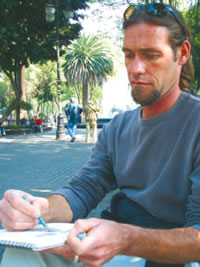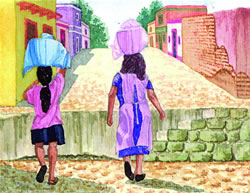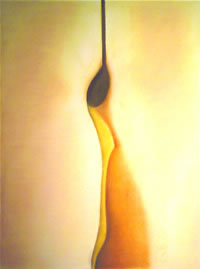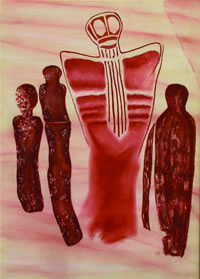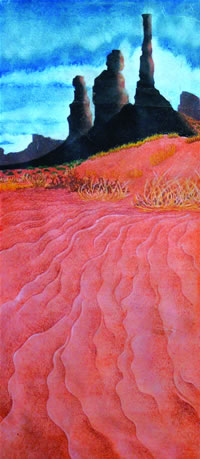Artist of the Month - March 2006 Eric Trenbeath
Framed |
|||||
These are a few of the questions that artists often ponder, left eternally without a definite answer. Eric Trenbeath is no exception, particularly since he is involved in art from so many angles within the process. He is primarily known in town as co-owner, with his wife, Michelle, of the framing shop, Framed Image. In an extension of this work, he produces graphic designs for Utah businesses, such as the Moab Music Festival, the Utah Guide and Outfitters and Canyon Springs Consulting. Not surprisingly, Trenbeath also pursues art through his own drawings and paintings. Working primarily in watercolors and pastels, he has painted subjects ranging from landscapes to animals, figures to abstracts. Originally from Salt Lake City, he was attracted to Moab because of its striking desert landscapes, which were his primary inspiration. Trenbeath, who holds degrees in graphic design and literature, found the fragile treasures of the barren landscapes captivating. He immersed himself in “traveling through them–almost obsessively and often, solo.”
And sure enough he found it. The better life manifested itself into alternating between being a ski bum in Alta and a river guide in Moab, which lasted about eight years. Although art didn’t factor in too heavily into this new lifestyle, he did find time to realistically render the mountains into aesthetically pleasing watercolors. During this time, he met Michelle, who is fluent in Spanish, and they decided to move down to Oaxaca, Mexico for one year. This change of lifestyle and scenery resulted in new subject matter for his paintings. Trenbeath produced colorful renditions of the lively street scenes, such as the two women walking down a cobbled street in the watercolor, “Tlayudas.”
After Mexico, the couple decided to move to Moab permanently. Trenbeath learned framing while studying art at the Salt Lake Community College. Seeing a niche he could fill and a way to stay in the art industry, he and Michelle opened the only framing store in town, Framed Image. Moab has been a good fit for Trenbeath as his business and art are thriving. His interest in art is ubiquitous, manifested in how many ways he has become involved in the artist community here. Inspired by the strong support he saw artists receive in Mexico from the community and the government, who subsidized streets and areas for artists to display and sell their work, Trenbeath has become a cornerstone in the art community here. In addition to the framing services and graphic design he offers through Framed Image, he coordinates the Moab Art Walk, a bi-monthly event that invites people to meet selected artists and view their work displayed in over ten participating shops, cafes and galleries (see box for details). Trenbeath created the Art Walk logo depicting footprints and it seems an appropriate symbol of the mark he is imprinting on the local art scene. He has also joined an informal group of professional artists who gather weekly to hire a model and portray the human form.
Although his early paintings are detail-oriented realistic representations, what he did not include in the painting seems as important to him as what he did. This drive to discover what remains hidden explains in part his eventual move into abstracts. He explains what drives him as, “I see something sensual and mysterious in nearly everything. I want to taste, touch, experience, and/or merge with the essence of it all.” In “Self Portrait,” Trenbeath has depicted a lean male abdomen with so much accuracy that it forces the viewer to do a double-take to ensure it is not actually a photograph. What is particularly intriguing about this work is its composition. He has captured the torso from neck to just above the groin, but he creates an asymmetry by not centering it. The right hand side of the figure is cut off, leaving interesting negative space on the left. Despite his desire to depict the figure under the harsh scrutiny of reality, he chooses in his composition to leave much of the subject hidden. Again, what is not there seems as important as what is. Like many contemporary local artists, he is drawn to the work of those who passed before–hundreds of years before. Several of his works depict pictographs of haunting triangular figures originally painted on sandstone by the Anasazi. Understandably, the mysterious forms composed of strong lines and geometry are a natural attraction for an artist fascinated with the desert and shapes.
In addition to finding pictographs inspiring, he enjoys depicting Navajo sandstone, whose rounded lines evince a woman’s curves. Most recently, his work is taking abstract forms, wherein he merges the elements that draw him to figures and landscape. In “A Soft Place,” the flesh-colored walls of a what appears to be a slot canyon mimic the lines of a woman’s body. The elliptical abyss that appears around the middle of the work creates a focal point which summons the viewer’s eye and imagination-what lies within? A thick straight line runs from the top of this spot to the top of the painting. Its straightness stands in sharp contrast to the soft lines and rounded depth of the walls, creating an equilibrium in the work evocative of the balance between yin and yang. As Trenbeath’s painting evolves, he’s finding a more expressionist side in his abstract work. He gives the impression of an artist whose previous work has been building blocks to the brink on which he now finds himself. His new abstract works speak of a recently found confidence in his own ability as a painter and a willingness to further explore the ethereal world to which art opens the door. While Trenbeath may not have resolved the eternally probing questions regarding what constitutes art, he has managed to find a satisfying answer to the question of how to make a living out of it. He has managed to frame his endeavors of pursuing his own creativity while working within the industry of art. |
